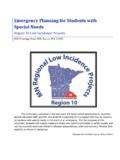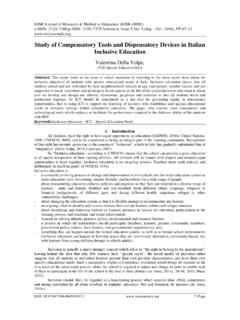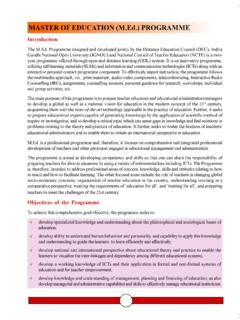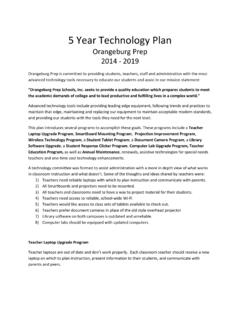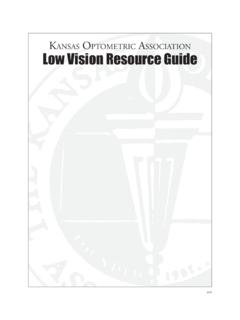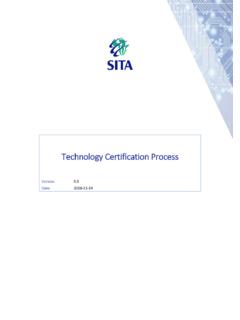Transcription of Wearable Assistive Devices for the Blind - Universidad
1 Wearable Assistive Devices for the Blind Ramiro Vel zquez Universidad Panamericana, Aguascalientes, Mexico Abstract Assistive Devices are a key aspect in Wearable systems for biomedical applications, as they represent potential aids for people with physical and sensory disabilities that might lead to improvements in the quality of life. This chapter focuses on Wearable Assistive Devices for the Blind . It intends to review the most significant work done in this area, to present the latest approaches for assisting this population and to understand universal design concepts for the development of Wearable Assistive Devices and systems for the Blind .
2 Keywords Assistive technology, reading/mobility aids, Wearable Devices and systems. 1 Introduction Target population Globally, an estimated 40 to 45 million people are totally Blind , 135 million have low vision and 314 million have some kind of visual impairment [1]. The incidence and demographics of blindness vary greatly in different parts of the world. In most industrialized countries, approximately of the population is Blind while in developing countries it rises to 1%. It is estimated by the World Health Organization (WHO) that 87% of the world's Blind live in developing countries. Over the last decades, visual impairment and blindness caused by infectious diseases have been greatly reduced (an indication of the success of international public health action), but there is a visible increase in the number of people who are Blind or visually impaired from conditions related to longer life expectancies.
3 The great majority of visually impaired people are aged 65 years or older. It is estimated that there is a per-decade increase of up to 2 million persons over 65 years with visual impairments. This group is growing faster than the overall population. In younger groups, blindness and visual impairment is mainly due to birth defects and uncorrected refractive errors. In the first case, most of the causes are in the brain rather than in the eye while in the second one, they are conditions that could have been prevented if diagnosed and corrected with glasses or refractive surgery on time. It is estimated that by the year 2020, all Blind -related numbers will double.
4 R. Vel zquez, Wearable Assistive Devices for the Blind . Chapter 17 in A. Lay-Ekuakille & Mukhopadhyay (Eds.), Wearable and Autonomous Biomedical Devices and Systems for Smart Envi-ronment: Issues and Characterization, LNEE 75, Springer, pp 331-349, 2010. Dimension of the problem Of all sensations perceived through our senses, those received through sight have by far the greatest influence on perception. Sight combined with the other senses, mainly hearing, allow us to have a world global perception and to perform actions upon it. For the Blind , the lack of sight is a major barrier in daily living: information access, mobility, way finding, interaction with the environment and with other people, among others, are challenging issues.
5 In fact, school and working-age Blind have very high analphabet and unemployment rates. For example, in the US, the Blind unemployment rate is around 75% while only 10% of the Blind children receive instruction in Braille [2]. Despite efforts, a true is that most schools and employers cannot accommodate Blind people. In consequence, the person who is Blind and his/her family face important socioeconomic constraints. The issue of the Blind becomes a very serious problem in terms of health and social security. Costly-in home expenses, nursing home care and welfare expenses on unemployment and health services have to be absorbed by the state.
6 A state action to enable the Blind /visually impaired to live independent and productive lives has been to teach them new ways to accomplish routine daily tasks. A great variety of specialists is involved: special education teachers, Braille teachers, psychologists, orientation and mobility specialists, low-vision specialists and vision rehabilitation therapists to name a few. Evidently, this involves a very high cost that has to be absorbed by the state. Moreover, the availability of funding and qualified personnel is insufficient to cover the actual population s demand. Other means are urgently needed to assist this population. Assistive technology Advances of technology and better knowledge in human psycho-physiological 3D world perception permit the design and development of new powerful and fast interfaces assisting humans with disabilities.
7 For the Blind , research on supportive systems has traditionally focused on two main areas: information transmission and mobility assistance. More recently, computer access has been added to the list [3]. Problems related to information transmission concern reading, character recognition and rendering graphic information about 2D and 3D scenes. The most successful reading tool is the Braille dot code. Introduced by Louis Braille in the 19th century, it has now become a standard worldwide. Inventions addressing the problems of character recognition and pictorial representation mostly consist of tactile displays. They permit character and graphic recognition by feeling a tactile version of them.
8 Problems related to mobility assistance are more challenging. They involve spatial information of the immediate environment, orientation and obstacle avoidance. Many electronic travel aids (ETAs) for safe and independent mobility of the Blind have been proposed over the last decades. They all share the same operation principle: they all scan the environment (using different technologies) and display the information gathered to other sense (mainly hearing and touch). With the internet revolution of the last years, problems related to computer access for the Blind arose. Popular solutions are voice synthesizers, screen magnifiers and Braille output terminals.
9 Voice synthesizers practically read the computer screen; screen magnifiers enable on-screen magnification for those with low-vision and Braille output terminals are plugged to the computer so that information on the screen is displayed in Braille. Wearable and portable Devices This chapter reviews Wearable Assistive Devices for the Blind and less portable Assistive Devices . There is a slight difference between both. Wearable Devices are distinctive from portable Devices by allowing hands-free interaction, or at least minimizing the use of hands when using the device. This is achieved by Devices that are actually worn on the body such as head-mounted Devices , wristbands, vests, belts, shoes, etc.
10 Portable Devices are usually compact, lightweight, they can be easily carried (but not worn) by the user and require constant hand interaction. For example: tactile displays, electronic canes, mobile phones, laptop computers, etc. The area of Wearable Devices is currently a hot research topic in assisting people with disabilities such as the Blind . As this area is still very much young and experimental, there are not many mature commercial products with a wide user base. 2 Wearable technologies for the Blind A number of Wearable Assistive Devices have been developed as task-specific solutions for activities such as reading and travel. Given the fact that sight is missing, they try to open new communication channels through hearing and touch.

